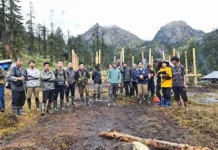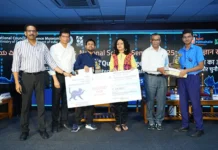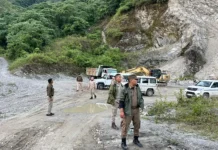PASIGHAT, Nov 28: East Siang DC Kinny Sigh urged the people to contribute towards water conservation “and create a mass movement for water catchment area protection.”
Singh, who is also the chairman of the district drinking water catchment area protection board (DDWCAPB), was addressing a workshop organized here on Thursday by the PHE&WS department to sensitize the people to the need to protect the water catchment areas.
“The DDWCAPB should motivate the citizens to conserve natural water sources,” Singh said, adding that “increasing population density and demand might lead to quick water runoff, soil erosion, and water shortage in the coming days.”
She said protecting water sources is a crucial step in ensuring provision of safe drinking water.
“Protected catchment areas provide significant natural barriers to contamination and yield high-quality water; all stakeholders should take a proactive step and extend cooperation to the water catchment protection draft preparation at the district level to enable the authority to recommend to the state-level drinking water catchment area advisory board,” the DC said.
PHE&WS EE M Dupak informed that a drinking water catchment “is an area of land where rainfall is collected, which goes into rivers and streams or seeps into the soil to become groundwater, where it is stored in underground aquifers or any available spaces.
“The captured water later becomes drinking water for the community. Felling of trees directly results in reduction of discharge of groundwater,” he added.
AE Tadung Padun made a PowerPoint presentation on the status report, and delivered a lecture on the measures to be taken up by the DDWCAPB.
The ABK’s district unit general secretary, Talut Siram, suggested creating “massive awareness at the grassroots level for preparation of the district-level draft/plan for sustainable implementation process of the upcoming law/act in the district.”
Meanwhile, in Lower Subansiri HQ Ziro, expressing apprehension over “dilution of the Arunachal Pradesh Protection of Drinking Water Catchment Areas Bill, 2019 with the Village Forest Act, which is already in place,” DFO Koj Rinya emphasized on exempting rural and semi-urban areas from the act.
She said this during a workshop on the Arunachal Pradesh Protection of Drinking Water Catchment Areas Bill, 2019, conducted by the PHE&WS department here recently.
Stating that “water is required not just for drinking but also for agriculture and other purposes,” she suggested changing the wording in the bill from ‘drinking water’ to just ‘water’.
Rinya opined that the bill should be regulatory in nature, instead of prohibitory. She also suggested that the village forest management committee, which is already in place, be strengthened.
PHE&WS AE Hibu Kojin made a presentation on the status of the water supply sources in the district and the urgent need of a law to protect the drinking water sources, which he said “are dwindling day by day.”
ADTH Hage Tatang advocated making collective efforts to check construction and quarrying activities in and around the water sources.
Emphasizing on Clause 11 of the act, Tax & Excise Assistant Commissioner Punyo Yaje suggested that “the nodal department should decide on the requirement of catchment area as per terrain and field condition of the area.”
WRD AE Tanyang Chalyang asked the participants to support the bill “for the sake of future generations.”
Clearing apprehension that the forest area, when declared a catchment area, might be parted from an individual or clan owner, he said “the bill will act as a deterrent to destruction of the catchment area only, and shall not be grabbed from the villagers.”
While the head gaon buras and head gaon buris (HGB) of the district welcomed the bill, some of them voiced apprehension that the owners might object to parting with their forest land.
HGB Nani Hanya spoke on the need to “check and balance quarrying and deforestation,” while HGB Hage Siira spoke about the ownership system of forest land in the plateau.
HGB Bath Halley spoke on “the ignorance of some villages that destroyed forest areas without knowing how it affects the rainfall pattern and water sources,” while HGB Koj Oche pledged to protect the catchment areas and expressed her support to the bill.
The goan buras and buris, however, echoed the need for creating awareness on the bill at the village level.
ADC Nending Chatung lauded the government “for bringing such a bill at a juncture when water sources are drying up at a rapid phase.” He asked the participants to support the bill “as the government is taking this step for the good of its citizens.”
PHE&WS EE Kago Habung described the draft bill, while JE Khyoda Sanjoy made a presentation on the draft bill. (DIPROs)



